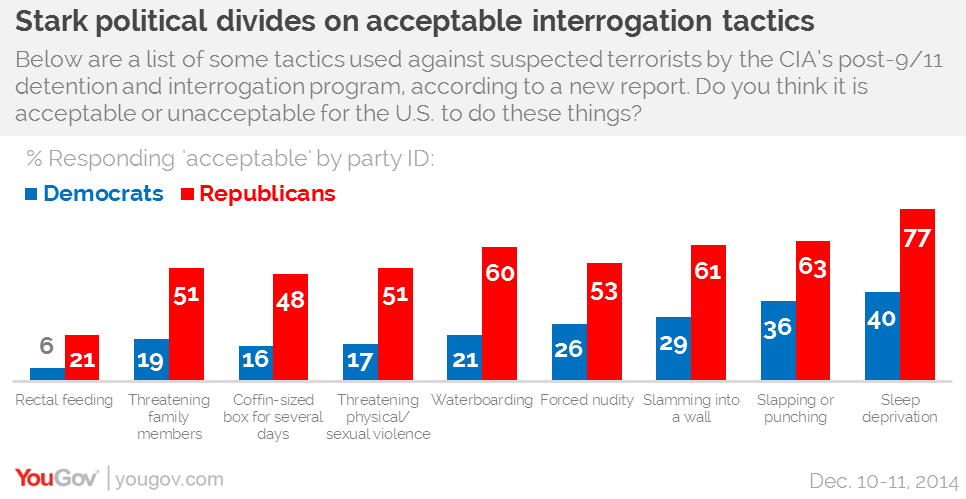Most Americans
think torture can be justified, but hardly anyone thinks "rectal
feeding" is acceptable
This week saw the
release of a long-awaited U.S. Senate report detailing the post-9/11 CIA
detention and interrogation program with a focus on the agency's the use of
torture. According to the report, interrogation procedures used on some
detainees that were much harsher and less effective than previously
acknowledged. Critics, including former CIA interrogators and Bush
administration officials, have called the report politically motivated and
inaccurate.
When Americans are
asked about suspected terrorists “who may know details about future attacks
against the U.S.”, only 24% are prepared to say the use of torture is “never”
justified. Nearly as many, 20%, say the use of torture is “always” justified,
while the remainder say it’s either “sometimes” (28%) or only “rarely” (18%)
justified – a total of 66% who are unwilling to rule out torture completely.
There has been little change in views from April, before the release of the
report, when 22% said torture was never justified.
Ask people
specifically about interrogation tactics detailed in the report, and a more
complicated picture emerges. In fact only one tactic – depriving a detainee of
sleep – is deemed acceptable by the majority of the public. More people reject
than accept seven of the eight other tactics, including waterboarding, which is
seen as unacceptable by 45-35%.

By far the least popular tactic was
feeding a detainee by pumping a food into his anus, a practice the report calls
“rectal feeding”, which three-quarters of Americans say is unacceptable.
Like so many other issues, views
about torture are highly polarised politically. 38% of Democrats say torture is
never justified, compared to just 11% of Republicans. Republicans are also more
open to all of the specified tactics than their Democratic counterparts. In
fact, while Democrats tend to say all of the nine tactics are unacceptable,
Republicans tend to say all of them are acceptable with one exception – people
of all political persuasions reject the use of rectal feeding.

People are divided along these same political lines
on several other aspects of the debate over the torture, some addressed by the
report. 54% Democrats believe the information gained through torture is
unreliable; 56% of Republicans think it’s reliable. 58% of Democrats think it
is possible to fight terrorism without using torture, while 46% of Republicans
think it’s impossible.
PA image
This article has been edited for clarity.
WEB: www.sinfulandwicked.co.uk MOB: 07426 490 214 TWITTER: @sinfulandwicked




